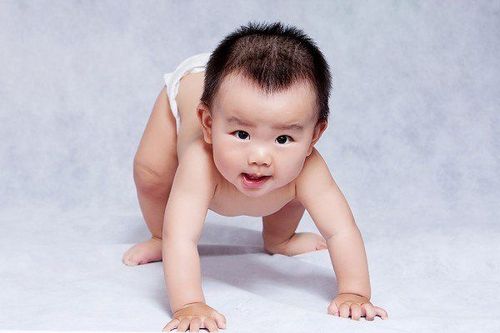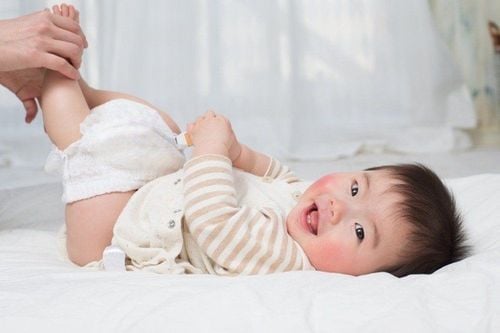This is an automatically translated article.
Crawling is the first method for babies to move around on their own effectively. Your baby will start by learning how to balance on his hands and knees. The child will then figure out how to move forward and backward by pushing forward with their knees. At the same time, the child will strengthen the muscles in the lower extremities to help the child soon be able to walk. Achieving this milestone will help children explore the world around them more and help them develop holistically.
1. The average age for a baby to crawl.
Most babies will learn to crawl between the ages of 6 months and 12 months. Some babies use a different method of locomotion around this time - such as crawling (turning or rolling), tummy or rolling.
Crawling on hands and knees is important for developing bilateral coordination, upper and lower extremity coordination, which helps support nerve development important for later reading and writing . In addition, feeling the hands and knees against the ground provides the essential perception of "body in space". And it strengthens the shoulder muscles, supporting other fine motor skills like feeding oneself, dressing, and holding crayons or pencils.
Crawling is a method to help children change the position of their head relative to the ground, help develop balance and coordination, develop vision, depth perception, and hand-eye coordination.
Most babies start crawling or crawling (or crawling or rolling) between 6 and 12 months. And for many babies, the crawling phase doesn't last long - once they feel independent, they can start to stand up and learn to walk very early.
2. Children's crawling patterns
There are many ways for a baby to move from point A to point B without walking. In fact, there are many different types of crawling and each baby will have the one that works best for him or her. And experts say that's fine. Here are some of the most common styles, according to the American Academy of Pediatrics:
Classic Cow Style. This is what everyone thinks of when they hear the word "cow". Babies will crawl on the floor on their hands and knees, alternating hands with opposite knees, with their stomachs resting on the floor. Butt crawl. Newborns sit on their buttocks and use their hands to push themselves forward. Rolling. Some children may prefer to roll their whole body in the direction they want. Troop style . You may also hear this method of movement referred to as the “command cow”. Children lie on their stomach, spread their legs back and use their hands to pull or push them forward, similar to the military crawling position. Crab crawl. In this variation, the infant pushes himself forward with his hands while keeping his knees bent, like a crab gliding in the sand. Bear-style cow. Similar to the classic cow style. Here's a variation, babies keep their legs straight and the soles of their feet in contact with the ground.

Trẻ tập bò kiểu gấu
3. Signs that your baby will soon learn to crawl
When your child is playing on the floor, you may have been monitoring the situation closely. Start watching for the most common signs that your baby is ready to crawl.
One sign is when an infant can roll from tummy to back and vice versa. Another sign of readiness is when your baby is able to bring himself from a prone position to a sitting position.
Some babies will stand up on their hands and knees, but the position is still unstable. Other young people even start trying to push or pull themselves with their arms while lying on their stomach, which you may recognize as the beginning of a baby's ability to crawl. These are all signs that your baby may be about to start hitting the next milestone.
Some babies skip crawling completely. They will progress straight to standing and walking with support.
4. What can you do to encourage your baby to crawl?
4.1. Give your baby plenty of tummy time Even babies can benefit from some wiggle time on mom's tummy. Think of it as a very early strength training exercise. Tummy time really helps babies develop strength in their shoulders, arms, and torso. Eventually, they'll use those muscles to help them start crawling.
4.2. Create a safe space Clean up an area of your home, be it the living room or your child's bedroom. Eliminate any potential hazards and make sure the area is safe. Let your baby have some free time to explore but be carefully supervised.
4.3. Stimulating your baby with toys Place a favorite toy or perhaps an attractive new object out of reach. Encourage the child to reach for it and see if he or she moves towards it. This can also prepare the child for steps in the near future.
In fact, research shows that babies who crawl, set their sights on objects in the room, and retrieve them at around 11 months of age are more likely to walk by 13 months.

Cha mẹ nên tạo không gian an toàn cho trẻ tập bò
5. Keep children safe when starting to crawl
Don't wait until your baby is moving to start guarding your home. Go ahead and start addressing potential hazards like:
Drawers. Install properly functioning safety latches and locks on cabinet doors and drawers, especially if they contain cleaning products, medicines, knives, matches or other items that could harm your baby. Window coverings. Those dangling cords from a set of blinds or curtains can be a very tempting object for your baby to grab, but it can also be a choking hazard. Stair. According to the US Consumer Product Safety Commission, using sturdy safety barriers is a must to keep babies from falling down stairs. Barriers should be at both the top and bottom of the stairs. Power sockets. It's a good idea to purchase a series of outlet covers and install them in all sockets to prevent children from touching them. Sharp corners. The indoor table may have to be replaced if it has sharp corners. Using rubber edge and corner guards can make your furniture and fireplace safer for your baby on the go. Heavy objects and furniture. You can install anchors or other devices to secure TVs, bookshelves, and other heavy objects so your child doesn't accidentally and crush them. Windows. You can purchase special window screens or safety nets to prevent falls from doors or balconies. Water tap. Anti-scald devices on faucets can prevent burns from hot water. (You can also adjust the temperature of your water heater.) The National Safety Council also recommends keeping other dangerous items, like batteries and guns, out of the reach of children.
6. When do you need to care when the baby is still not able to crawl?
Babies develop skills using different methods and different timetables. But if your baby doesn't show interest in crawling, find ways to move his arms and legs in a coordinated motion, or use both arms and both legs equally by the time he's a year old, take him to the doctor. doctor. Remember that premature babies may reach this and other milestones several months later than their peers.
Before you panic that your 9, 10, or 12 month old isn't crawling yet, double check the following.
Protected baby in your home Give your baby plenty of time to play on the floor Avoid using strollers, cribs, booster seats or spot games. Encourage your baby to find toys on the floor. If you've done all of that and your child doesn't have any other health problems or developmental delays, it will take some time and patience to train your child to reach this milestone.
During this phase, you can simply wait. Some babies reach developmental milestones only a little later than others. Give your baby some time to experiment and figure it out.
But if your baby is one year old and still doesn't show interest in crawling, standing or walking, go ahead and check with your doctor. If your child is not using his arms and legs on both sides of his body, this could be a sign of suspicion.
Sometimes a baby may have a developmental or neurological problem and depending on the diagnosis, your child's doctor may suggest trying mobility or physical therapy to address the problem. that subject.
After your baby has mastered crawling, the baby's next milestone is full mobility, or learning to walk. To achieve that, children will soon start trying to overcome everything they can reach. Once the baby feels balanced on his feet, he will be ready to stand and move on his own, possibly needing to lean on some support such as a table, chair or wall. Then it's only a matter of time until the child can walk, run and jump.
Crawling is one of the important milestones, marking the baby's ability to begin to move and explore the world around them. Create a safe environment in which your child can reach this milestone.
For children to be healthy and develop well, it is necessary to have a nutritious diet in terms of quantity and quality balance. If children are not provided with adequate and balanced nutrients, it will lead to diseases of excess or lack of nutrients, which adversely affect the comprehensive development of children in terms of physical, mental and motor skills.
Parents should supplement their children with supportive products containing lysine, essential micro-minerals and vitamins such as zinc, chromium, selenium, and B vitamins to help fully meet their child's nutritional needs. At the same time, these essential vitamins also support digestion, enhance nutrient absorption, help improve anorexia, and help children eat well.
Parents can learn more:
Signs of zinc deficiency in children
Micronutrient deficiency and failure to gain weight in children
Please regularly visit Vinmec.com website and update useful information to take care of your child. Take care of the baby and the whole family.
Reference source: babycenter.com













